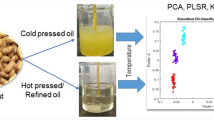Abstract
This study focuses on detecting and evaluating the adulteration in nut oil, which can cause health and food dangers. The two adulterants used during this study are cheaper vegetable oils and present a similar property with walnut oil, sunflower oil with a falsification percentage of 5.80–31.95%, and rapeseed oil with 4.33–29.37%. This adulteration was studied using Fourier transform infrared spectroscopy (FTIR) coupled with chemometrics, a new and specific approach. The spectra of the studied samples were determined by FTIR and were thermometrically analyzed by PLSR and PCR with two sorts of pretreatment, normalization, and first derivation. The results showed different functional groups of the nut oil. The most appropriate pretreatment that provides reliable calibration values (RMSE) and prediction (RMSEP) is the normalization preprocessing in the range of 3050 to 700 cm−1. The chemometrics results give the best model selected in the PLSR with an R2 of 0.998 for sunflower oil and 0.999 for rapeseed oil. According to this study, we have solved nut oil falsification by developing a chemometrics model that can detect and evaluate this adulteration.





Similar content being viewed by others
References
I. Oliveira, A. Sousa, I.C.F.R. Ferreira, A. Bento, L. Estevinho, J.A. Pereira, Total phenols, antioxidant potential and antimicrobial activity of walnut (Juglans regia L.) green husks. Food Chem Toxicol 46(7), 2326–2331 (2008). https://doi.org/10.1016/j.fct.2008.03.017
M.A. Rather, B.A. Dar, M.Y. Dar, B.A. Wani, W.A. Shah, B.A. Bhat, B.A. Ganai, K.A. Bhat, R. Anand, M.A. Qurishi, Chemical composition, antioxidant and antibacterial activities of the leaf essential oil of Juglans regia L. and its constituents. Phytomedicine 19(13), 1185–1190 (2012). https://doi.org/10.1016/j.phymed.2012.07.018
J.A. Pereira, I. Oliveira, A. Sousa, P. Valentão, P.B. Andrade, I.C.F.R. Ferreira, F. Ferreres, A. Bento, R. Seabra, L. Estevinho, Walnut (Juglans regia L.) leaves: Phenolic compounds, antibacterial activity and antioxidant potential of different cultivars. Food Chem Toxicol 45(11), 2287–2295 (2007). https://doi.org/10.1016/j.fct.2007.06.004
F. Stampar, A. Solar, M. Hudina, R. Veberic, M. Colaric, Traditional walnut liqueur – Cocktail of phenolics. Food Chem 95(4), 627–631 (2006). https://doi.org/10.1016/j.foodchem.2005.01.035
M. Carvalho, P.J. Ferreira, V.S. Mendes, R. Silva, J.A. Pereira, C. Jerónimo, B.M. Silva, Human cancer cell antiproliferative and antioxidant activities of Juglans regia L. Food Chem Toxicol 48(1), 441–447 (2010). https://doi.org/10.1016/j.fct.2009.10.043
P. Gao, R. Liu, Q. Jin, X. Wang, Comparative study of chemical compositions and antioxidant capacities of oils obtained from two species of walnut: Juglans regia and Juglans sigillata. Food Chem 279, 279–287 (2019). https://doi.org/10.1016/j.foodchem.2018.12.016
P. Gao, R. Liu, Q. Jin, X. Wang, Effects of processing methods on the chemical composition and antioxidant capacity of walnut (Juglans regia L.) oil. LWT 135, 109958 (2021). https://doi.org/10.1016/j.lwt.2020.109958
J.S. Amaral, S. Casal, J.A. Pereira, R.M. Seabra, B.P.P. Oliveira, Determination of sterol and fatty acid compositions, oxidative stability, and nutritional value of six walnut (Juglans regia L.) cultivars grown in Portugal. J Agric Food Chem 51(26), 7698–7702 (2003). https://doi.org/10.1021/jf030451d
A. Benamar, F. Mahjoubi, G.A. Ali, F. Kzaiber, A. Oussama, A chemometric method for contamination sources identification along the Oum Er Rbia river (Morocco). Bul Chem Commun 52(1), 159–171 (2020)
M. El Mouftari, F.Z. Mahjoubi, F. Kzaiber, W. Terouzi, G.A.M. Ali, S. Souhassou, A. Oussama, Study of oleaster oil’s falsification by aTR-FTIR and chemometrics tools. Egypt J Chem 64(6), 2747–2755 (2021)
B. Li, H. Wang, Q. Zhao, J. Ouyang, Y. Wu, Rapid detection of authenticity and adulteration of walnut oil by FTIR and fluorescence spectroscopy: A comparative study. Food Chem 181, 25–30 (2015). https://doi.org/10.1016/j.foodchem.2015.02.079
A. Oussama, F. Elabadi, S. Platikanov, F. Kzaiber, R. Tauler, Detection of olive oil adulteration using FT-IR spectroscopy and PLS with variable importance of projection (VIP) scores. J Am Oil Chem Soc 89(10), 1807–1812 (2012). https://doi.org/10.1007/s11746-012-2091-1
P. Liang, H. Wang, C. Chen, F. Ge, D. Liu, S. Li, B. Han, X. Xiong, S. Zhao, The use of Fourier transform infrared spectroscopy for quantification of adulteration in virgin walnut oil. J Spectrosc 2013, 305604 (2013). https://doi.org/10.1155/2013/305604
A. Hirri, M. Bassbasi, S. Souhassou, F. Kzaiber, A. Oussama, Prediction of polyphenol fraction in virgin olive oil using mid-infrared attenuated total reflectance attenuated total reflectance accessory–Mid-infrared coupled with partial least squares regression. Int J Food Prop 19(7), 1504–1512 (2015). https://doi.org/10.1080/10942912.2015.1059854
L. Wang, F. Lee, X. Wang, Y. He, Feasibility study of quantifying and discriminating soybean oil adulteration in camellia oils by attenuated total reflectance MIR and fiber optic diffuse reflectance NIR. Food Chem 95(3), 529–536 (2006). https://doi.org/10.1016/j.foodchem.2005.04.015
Author information
Authors and Affiliations
Corresponding author
Ethics declarations
Conflict of interest
The authors declare no competing interests.
Additional information
Publisher’s Note
Springer Nature remains neutral with regard to jurisdictional claims in published maps and institutional affiliations.
Rights and permissions
About this article
Cite this article
El Mouftari, M., Essafi, I., Khalidi, A. et al. Applications of FTIR and chemometrics methods in authenticity analysis of walnut oil. emergent mater. 5, 167–174 (2022). https://doi.org/10.1007/s42247-022-00351-5
Received:
Accepted:
Published:
Issue Date:
DOI: https://doi.org/10.1007/s42247-022-00351-5




